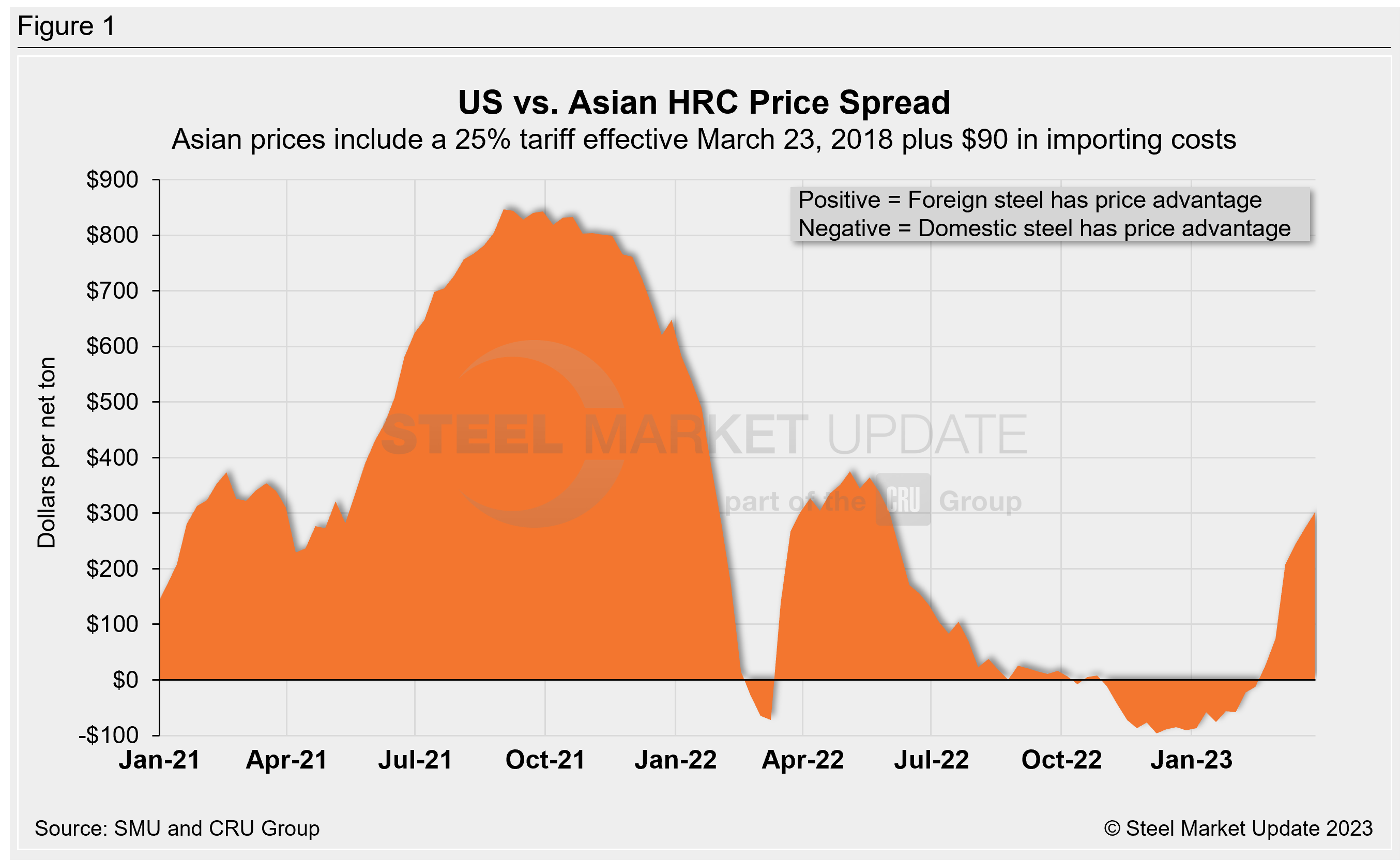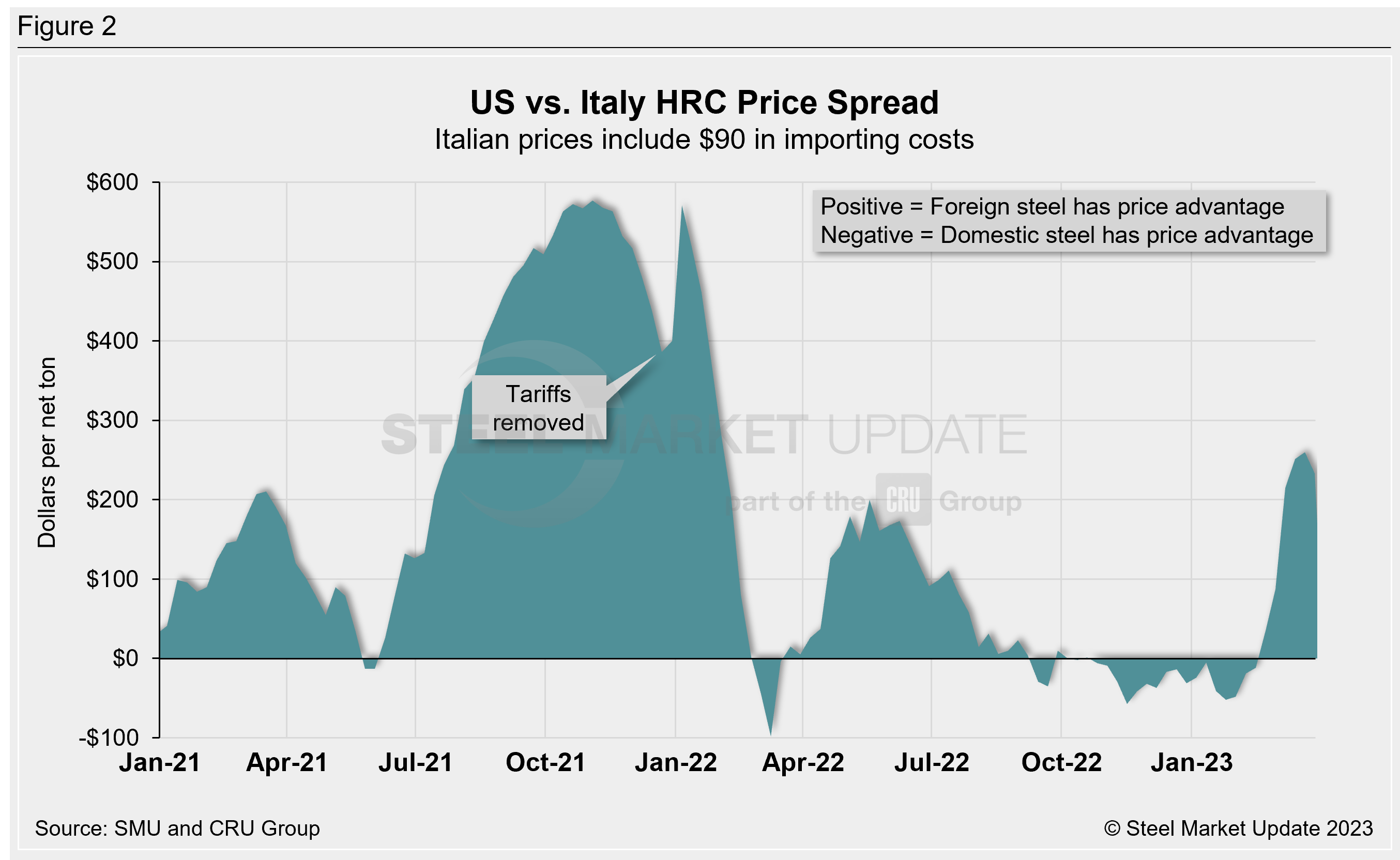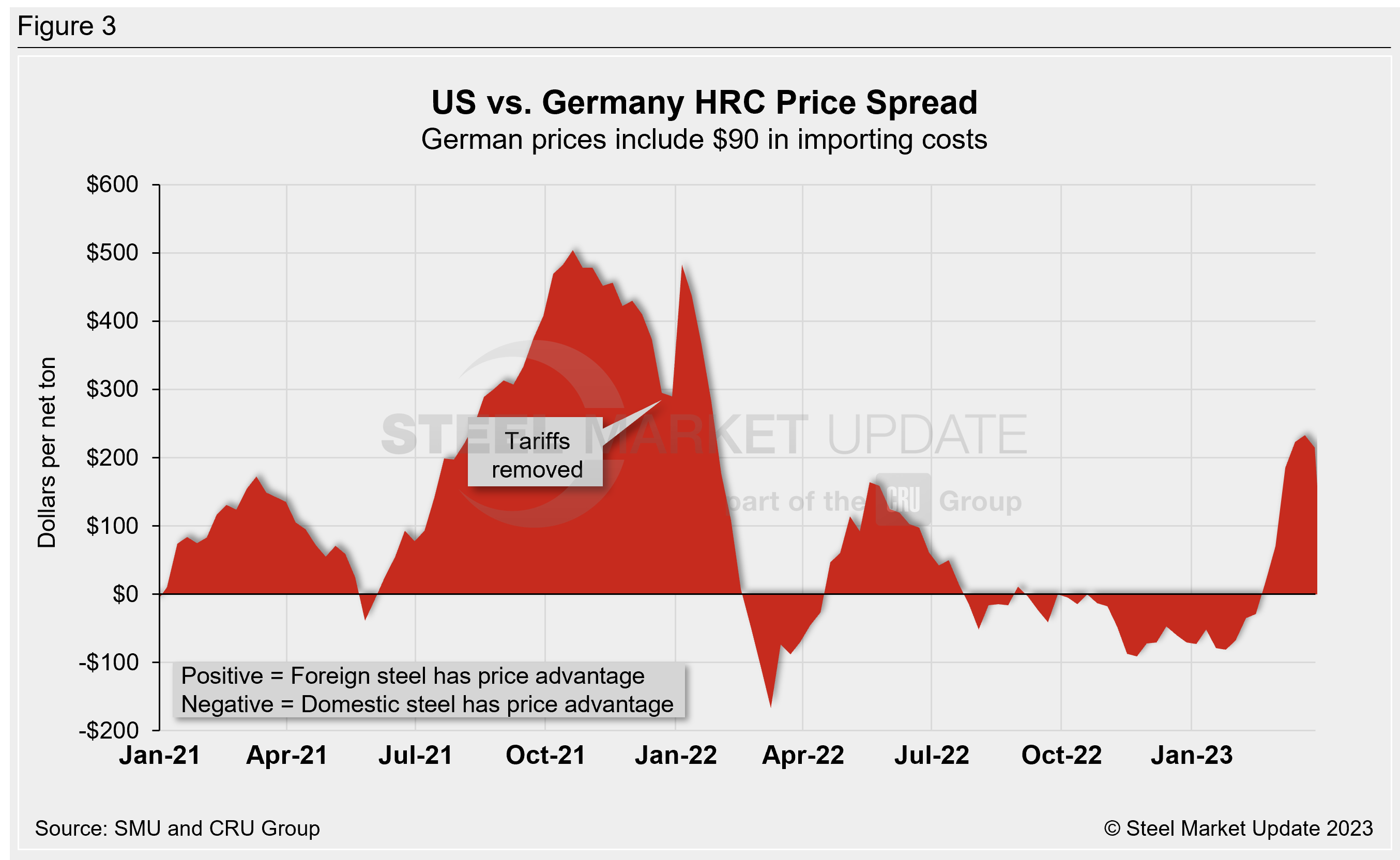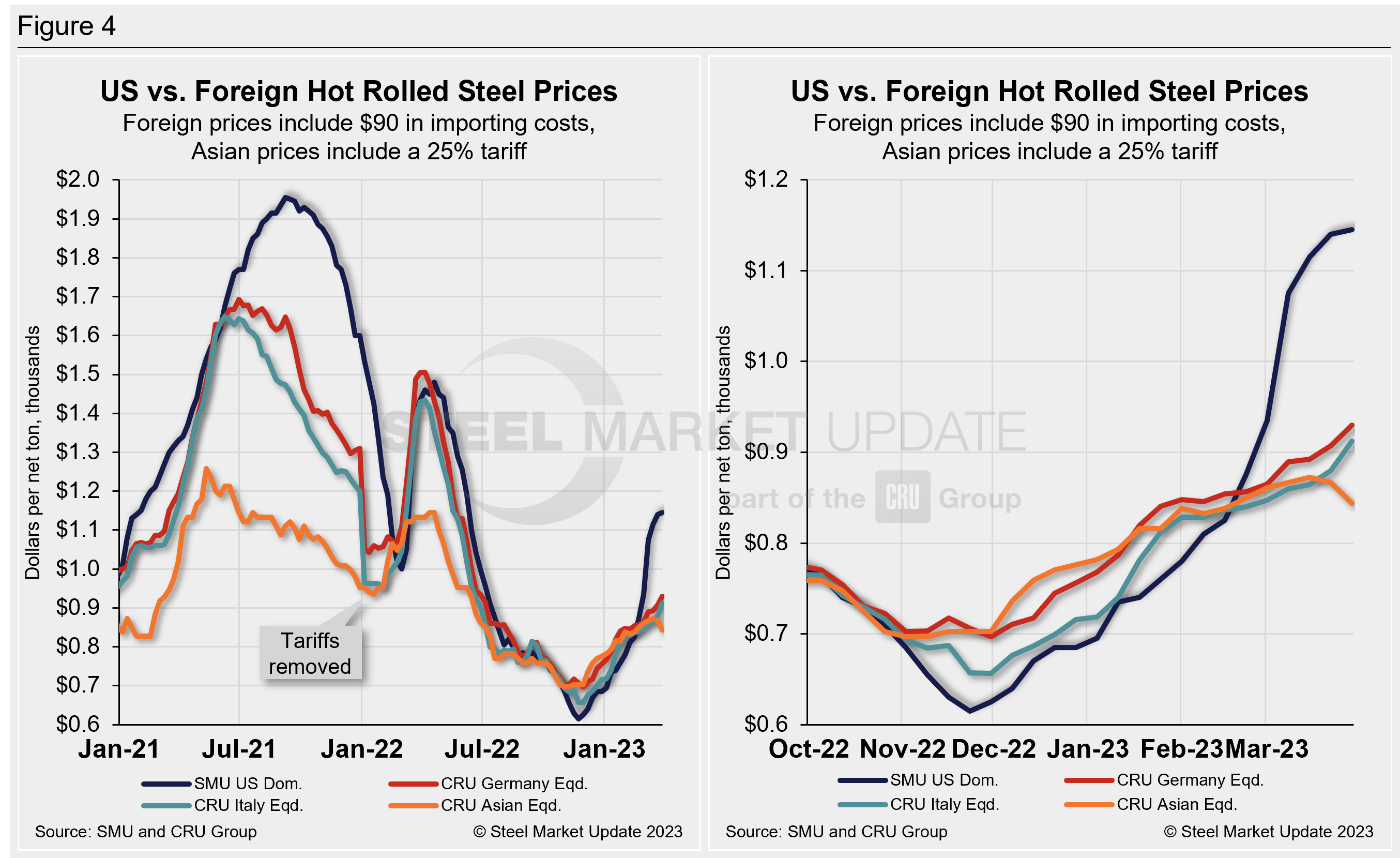SMU Data and Models
HRC Imports Remain Widely Attractive Over Higher US Sheet Prices
Written by David Schollaert
March 30, 2023
The appeal for imports of hot-rolled coil (HRC) remains strong even as US price gains have slowed, according to SMU’s latest foreign vs. domestic price analysis. And while we haven’t seen an official mill pricing notice in nearly three weeks, domestic tags continue to inch higher towards the targeted base price of $1,200 per ton ($60 per cwt) for HRC issued by Cleveland-Cliffs back on March 13.
![]() The price advantage domestic HRC had enjoyed over offshore material as recently as mid-February turned negative in a hurry in response to US mill tag hikes.
The price advantage domestic HRC had enjoyed over offshore material as recently as mid-February turned negative in a hurry in response to US mill tag hikes.
US HRC had held a price advantage over foreign hot band for 16 consecutive weeks. But that trend has turned completely negative over the past fix weeks as domestic HRC prices continue to rise at a much faster clip than tags abroad.
Domestic hot band is now 21.8% more expensive than foreign material. That premium is slightly lower than last week when domestic HRC was ~22% more costly than imported product.
US prices had been cheaper than foreign prices for the three regions we follow (Asia, Italy, and Germany) since the beginning of November after adding freight costs, trader margins, and applicable tariffs. That changed with US HRC prices rising $385 per ton since the beginning of February. US prices have shot up by $270 per ton thus far in March.
Domestic HRC held, on average, an $18-per-ton advantage over imported hot band as recently as Feb. 15. That flipped to a $250-per-ton disadvantage this week as US prices inched up further.
SMU uses the following calculation to identify the theoretical spread between foreign HRC prices (delivered to US ports) and domestic HRC prices (FOB domestic mills): Our analysis compares the SMU US HRC weekly index to the CRU HRC weekly indices for Germany, Italy, and east and southeast Asian ports. This is only a theoretical calculation because costs to import can vary greatly, influencing the true market spread.
In consideration of freight costs, handling, and trader margin, we add $90 per ton to all foreign prices to provide an approximate CIF US ports price to compare to the SMU domestic HRC price. Buyers should use our $90-per-ton figure as a benchmark and adjust up or down based on their own shipping and handling costs. If you import steel and want to share your thoughts on these costs, we welcome your insight at david@steelmarketupdate.com.
Asian Hot-Rolled Coil (East and Southeast Asian Ports)
As of Thursday, March 29, the CRU Asian HRC price decreased by $18 per ton from a week ago to $603 per net ton ($665 per metric ton); this was down $14 per ton from levels one month prior. Adding a 25% tariff and $90 per ton in estimated import costs, the delivered price of Asian HRC to the US is $844 per ton. The latest SMU hot-rolled average is $1,145 per ton, up $5 per ton from our previous price update, and up $210 per ton compared to our price one month ago.
US-produced HRC is now theoretically $301 per ton more costly than steel imported from Asia. This is a reversal from just six weeks ago, when domestic HRC had a $13-per-ton advantage over HRC from Asian markets.
Just a little over two months ago, we saw a $76-per-ton spread advantage for US HRC, among the biggest price advantages domestic HRC has had over Asian HRC in recent years.
The widest price advantage for Asian hot band was recorded nearly 16 months ago: $847 per ton in September 2021.

Italian Hot-Rolled Coil
Italian HRC prices increased WoW by $32 per net ton to $822 per ton ($907 per metric ton) this week, and are $65 per ton higher month-on-month (MoM). After adding import costs, the delivered price of Italian HRC is approximately $912 per ton.
Domestic HRC is now theoretically $233 per ton more expensive than imported Italian HRC. That spread is down $27 per ton WoW but still represents a nearly $245-per-ton reversal compared to six weeks ago when US HRC was $12 per ton cheaper than Italian product. As recently as Jan. 25, US HRC was in theory $52 per ton cheaper than imported Italian hot band.

German Hot-Rolled Coil
CRU’s latest German HRC price rose by $23 per ton WoW to $840 per net ton ($926 per metric ton) and is up $65 per ton MoM. After adding import costs, the delivered price of German HRC is roughly $930 per ton.
Domestic HRC is now theoretically $215 per ton more expensive than imported German HRC. That’s down $18 per ton WoW yet still a swing of $244 per ton given that US hot band held a $29-per-ton advantage over domestic hot band in mid-February.
US HRC had held a price advantage over German product for all but three weeks since late July.

Figure 4 compares all four price indices and highlights the effective date of the tariffs. The chart on the left shows historical variation from Jan. 1, 2021, through present. The chart on the right zooms in to highlight the recent decoupling of US and offshore HRC prices.

Notes: Freight is an important consideration in deciding whether to import foreign steel or buy from a domestic mill. Domestic prices are referenced as FOB the producing mill, while foreign prices are CIF the port (Houston, NOLA, Savannah, Los Angeles, Camden, etc.). Inland freight, from either a domestic mill or from the port, can dramatically impact the competitiveness of both domestic and foreign steel. It’s also important to factor in lead times. In most markets, domestic steel will deliver more quickly than foreign steel.
Effective Jan. 1, 2022, the traditional Section 232 tariff no longer applies to most imports from the European Union. it has been replaced by a tariff rate quota (TRQ). Therefore, the German and Italian price comparisons in this analysis no longer include a 25% tariff. SMU still includes the 25% Section 232 tariff on foreign prices from other countries. We do not include any antidumping (AD) or countervailing duties (CVD) in this analysis.
By David Schollaert, david@steelmarketupdate.com

David Schollaert
Read more from David SchollaertLatest in SMU Data and Models

SMU’s June at a glance
A look at SMU data for the month of June.

SMU Survey: Buyers’ Sentiment rebounds from multi-year low
Both of SMU’s Steel Buyers’ Sentiment Indices edged higher this week. Current Sentiment rebounded from a near five-year low, while Future Sentiment rose to a two-month high

SMU flat-rolled market survey results now available
SMU’s latest steel buyers market survey results are now available on our website to all premium members.

SMU Survey: Sheet lead times pull back after early-June blip, plate holds
Following the uptick seen two weeks ago, lead times eased this week for all four sheet products tracked by SMU, while plate lead times held steady, according to this week’s market survey.

SMU Survey: Pricing power abruptly shifts to steel buyers
The majority of steel buyers responding to our latest market survey say domestic mills are more willing to talk price on sheet and plate products than they were earlier this month. Sheet negotiation rates rebounded across the board compared to early June, while our plate negotiation rate hit a full 100%.
